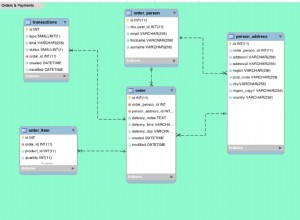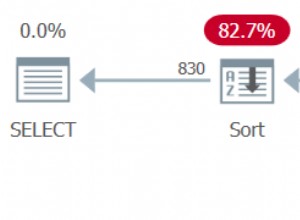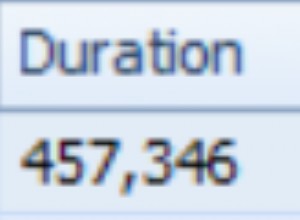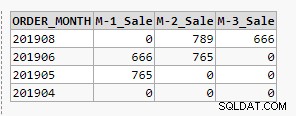Ya; dengan menggunakan LEAD() fungsi analitik, Anda dapat menghitung effdt berikutnya dalam tabel pekerjaan dan tunjangan, yang mempermudah kueri antar rentang.
Sesuatu seperti:
with dates as (select trunc(sysdate, 'yyyy') - 1 + level the_date,
to_number(to_char(trunc(sysdate, 'yyyy') - 1 + level, 'mm')) monthofyear,
to_number(to_char(sysdate, 'yyyy')) calendar_year
from dual
connect by level <= 365),
jobs as (select 123 emplid, to_date('01/02/2015', 'dd/mm/yyyy') effdt, 900 deptid, 'A' hr_status from dual union all
select 123 emplid, to_date('30/06/2015', 'dd/mm/yyyy') effdt, 900 deptid, 'I' hr_status from dual union all
select 123 emplid, to_date('01/08/2015', 'dd/mm/yyyy') effdt, 901 deptid, 'A' hr_status from dual),
benefits as (select 123 emplid, to_date('01/03/2015', 'dd/mm/yyyy') effdt, 'PPO' benefit_plan, 'A' status from dual union all
select 123 emplid, to_date('31/07/2015', 'dd/mm/yyyy') effdt, null benefit_plan, 'I' status from dual union all
select 123 emplid, to_date('01/09/2015', 'dd/mm/yyyy') effdt, 'HMO' benefit_plan, 'A' status from dual),
-- ********* end of mimicking your tables ********* --
j as (select emplid,
effdt,
deptid,
hr_status,
lead(effdt, 1, sysdate) over (partition by emplid order by effdt) next_effdt
from jobs),
b as (select emplid,
effdt,
benefit_plan,
status,
lead(effdt, 1, sysdate) over (partition by emplid order by effdt) next_effdt
from benefits)
select distinct j.emplid,
d.calendar_year,
d.monthofyear,
j.deptid,
b.benefit_plan
from j
inner join dates d on (d.the_date >= j.effdt and d.the_date < j.next_effdt)
inner join b on (j.emplid = b.emplid)
where d.the_date <= sysdate
and d.the_date between to_date (:year_prompt || '01-01', 'YYYY-MM-DD')
and to_date (:year_prompt || '12-31', 'YYYY-MM-DD') -- if no index on d.the_date, maybe use trunc(the_date, 'yyyy') = :year_prompt
and b.status = 'A'
and d.the_date between b.effdt and b.next_effdt
order by 1, 4, 2, 3;
EMPLID CALENDAR_YEAR MONTHOFYEAR DEPTID BENEFIT_PLAN
---------- ------------- ----------- ---------- ------------
123 2015 3 900 PPO
123 2015 4 900 PPO
123 2015 5 900 PPO
123 2015 6 900 PPO
123 2015 7 900 PPO
123 2015 9 901 HMO
123 2015 10 901 HMO
123 2015 11 901 HMO
(Jelas, Anda dapat mengecualikan dates , jobs dan benefits subqueries dari kueri di atas, karena Anda sudah memiliki tabel tersebut. Mereka hanya ada dalam kueri untuk mensimulasikan memiliki tabel dengan data di dalamnya tanpa perlu benar-benar membuat tabel.).
ETA:Ini adalah versi yang hanya menghitung 12 bulan berdasarkan tahun yang berlalu, yang mengurangi baris tanggal menjadi 12, bukan 365/366 baris.
Sayangnya, Anda masih memerlukan perbedaan, untuk memperhitungkan kapan Anda memiliki beberapa baris yang dimulai pada bulan yang sama.
Misalnya, dengan data dalam contoh berikut, Anda akan mendapatkan 3 baris untuk bulan ke-6 jika Anda menghapus perbedaannya. Namun, jumlah baris yang dioperasikan oleh pembeda akan jauh lebih sedikit daripada sebelumnya.
with dates as (select add_months(to_date(:year_prompt || '-01-01', 'YYYY-MM-DD'), - 1 + level) the_date,
level monthofyear,
:year_prompt calendar_year -- assuming this is a number
from dual
connect by level <= 12),
jobs as (select 123 emplid, to_date('01/02/2015', 'dd/mm/yyyy') effdt, 900 deptid, 'A' hr_status from dual union all
select 123 emplid, to_date('15/06/2015', 'dd/mm/yyyy') effdt, 900 deptid, 'I' hr_status from dual union all
select 123 emplid, to_date('26/06/2015', 'dd/mm/yyyy') effdt, 900 deptid, 'A' hr_status from dual union all
select 123 emplid, to_date('01/08/2015', 'dd/mm/yyyy') effdt, 901 deptid, 'A' hr_status from dual),
benefits as (select 123 emplid, to_date('01/03/2015', 'dd/mm/yyyy') effdt, 'PPO' benefit_plan, 'A' status from dual union all
select 123 emplid, to_date('31/07/2015', 'dd/mm/yyyy') effdt, null benefit_plan, 'I' status from dual union all
select 123 emplid, to_date('01/09/2015', 'dd/mm/yyyy') effdt, 'HMO' benefit_plan, 'A' status from dual),
-- ********* end of mimicking your tables ********* --
j as (select emplid,
trunc(effdt, 'mm') effdt,
deptid,
hr_status,
trunc(coalesce(lead(effdt) over (partition by emplid order by effdt) -1, sysdate), 'mm') end_effdt
-- subtracting 1 from the lead(effdt) since here since the original sql had d.the_date < j.next_effdt and we need
-- to take into account when the next_effdt is the first of the month; we want the previous month to be displayed
from jobs),
b as (select emplid,
trunc(effdt, 'mm') effdt,
benefit_plan,
status,
trunc(lead(effdt, 1, sysdate) over (partition by emplid order by effdt), 'mm') end_effdt
from benefits)
select distinct j.emplid,
d.calendar_year,
d.monthofyear,
j.deptid,
b.benefit_plan
from j
inner join dates d on (d.the_date between j.effdt and j.end_effdt)
inner join b on (j.emplid = b.emplid)
where d.the_date <= sysdate
and b.status = 'A'
and d.the_date between b.effdt and b.end_effdt
order by 1, 4, 2, 3;
EMPLID CALENDAR_YEAR MONTHOFYEAR DEPTID BENEFIT_PLAN
---------- ------------- ----------- ---------- --------------------------------
123 2015 3 900 PPO
123 2015 4 900 PPO
123 2015 5 900 PPO
123 2015 6 900 PPO
123 2015 6 900 PPO
123 2015 7 900 PPO
123 2015 9 901 HMO
123 2015 10 901 HMO
123 2015 11 901 HMO




